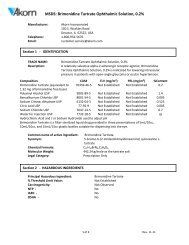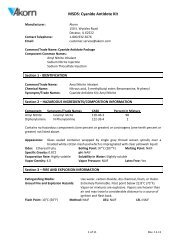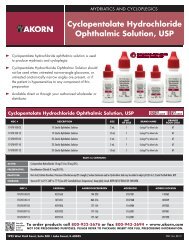to download the Akten ® FAQs PDF - Akorn, Inc.
to download the Akten ® FAQs PDF - Akorn, Inc.
to download the Akten ® FAQs PDF - Akorn, Inc.
Create successful ePaper yourself
Turn your PDF publications into a flip-book with our unique Google optimized e-Paper software.
3.5% Viscous Topical Ocular Anes<strong>the</strong>tic Gel<br />
Preservative Free<br />
What is <strong>Akten</strong> <strong>®</strong> ?<br />
AKTEN <strong>®</strong> FREQUENTLY ASKED QUESTIONS<br />
<strong>Akten</strong> <strong>®</strong> (lidocaine hydrochloride ophthalmic gel) 3.5%, is a prescription<br />
<strong>to</strong>pical ocular anes<strong>the</strong>tic. It is <strong>the</strong> first FDA-approved ophthalmic gel<br />
anes<strong>the</strong>tic in an optimal 3.5% dose and is preservative free.<br />
What are <strong>the</strong> features and benefits of <strong>Akten</strong> <strong>®</strong> ?<br />
Onset of action between 20 <strong>to</strong> 60 seconds and persists from 5 <strong>to</strong> 30<br />
minutes<br />
Viscous gel formulation for extended localized contact<br />
Only FDA-approved <strong>to</strong>pical lidocaine available for ocular procedures<br />
Physiological pH: 5.5 <strong>to</strong> 7.5<br />
S<strong>to</strong>re at room temperature: 15° <strong>to</strong> 25° C (59° <strong>to</strong> 77° F)<br />
Water soluble<br />
What is <strong>Akten</strong> <strong>®</strong> indicated for?<br />
<strong>Akten</strong> <strong>®</strong> is a local anes<strong>the</strong>tic indicated for ocular surface anes<strong>the</strong>sia<br />
during ophthalmologic procedures.<br />
What procedures will use <strong>Akten</strong> <strong>®</strong> ?<br />
Any procedure where a <strong>to</strong>pical anes<strong>the</strong>tic would be used including, but not<br />
limited <strong>to</strong>: prior <strong>to</strong> cataract surgery, intravitreal injections, refractive surgery<br />
including LASIK, supplemental <strong>to</strong>pical anes<strong>the</strong>tic after peribulbar or<br />
retrobulbar block, contact lens exam of retina, ALT/SLT lasers, retinal lasers,<br />
retinal cryoretinopexy, pneumatic retinopexy, scleral depression examinations,<br />
conjunctival or corneal foreign body removal, gonioscopy, suture placement,<br />
removal of corneal sutures, removal of conjunctival sutures, removal of lid<br />
sutures, anterior chamber paracentesis, placement of electroretinographic<br />
lenses, lens placement for YAG laser, vitreous biopsy, conjunctival biopsies,<br />
minor lid procedures, pterygium surgery, strabismus adjustment surgery,<br />
conductive kera<strong>to</strong>plasty, pars plana vitrec<strong>to</strong>my, and trabeculec<strong>to</strong>my.<br />
How is <strong>Akten</strong> <strong>®</strong> administered?<br />
The recommended dose of <strong>Akten</strong> <strong>®</strong> is 2 drops applied <strong>to</strong> <strong>the</strong> ocular surface<br />
in <strong>the</strong> area of <strong>the</strong> planned procedure. <strong>Akten</strong> <strong>®</strong> may be reapplied <strong>to</strong> maintain<br />
anes<strong>the</strong>tic effect.<br />
What are <strong>the</strong> ingredients of <strong>Akten</strong> <strong>®</strong> ?<br />
<strong>Akten</strong> <strong>®</strong> contains 35 mg of lidocaine hydrochloride per mL as <strong>the</strong> active<br />
ingredient. <strong>Akten</strong> <strong>®</strong> also contains Hypromellose, Sodium Chloride, and Water<br />
for Injection as inactive ingredients in <strong>the</strong> 1 mL tube configuration. The pH<br />
may be adjusted <strong>to</strong> 5.5 <strong>to</strong> 7.5 with Hydrochloric Acid and/or Sodium<br />
Hydroxide. <strong>Akten</strong> <strong>®</strong> is preservative free.<br />
How is <strong>Akten</strong> <strong>®</strong> packaged?<br />
<strong>Akten</strong> <strong>®</strong> (lidocaine hydrochloride ophthalmic gel) 3.5% is supplied as a<br />
clear gel for single patient use in a 1 mL fill in a white polyfoil tube. The<br />
NDC# is 17478-792-01.<br />
<strong>Akten</strong> <strong>®</strong> use in specific populations.<br />
Pregnancy. Pregnancy Category B – Reproduction studies for lidocaine<br />
have been performed in both rats and rabbits. There was no evidence<br />
of harm <strong>to</strong> <strong>the</strong> fetus at subcutaneous doses up <strong>to</strong> 50 mg/kg lidocaine<br />
(more than 800 fold greater than <strong>the</strong> human dose on a body weight<br />
basis) in <strong>the</strong> rat model. There are however, no adequate and well<br />
controlled studies in pregnant women. Because animal reproduction<br />
studies are not always predictive of human response, this drug should<br />
be used in pregnancy only if clearly needed.<br />
Nursing Mo<strong>the</strong>rs – Lidocaine is secreted in human milk. The clinical<br />
significance of this observation is unknown. Although no systemic<br />
exposure is expected with administration of <strong>Akten</strong> <strong>®</strong> , caution should be<br />
exercised when <strong>Akten</strong> <strong>®</strong> is administered <strong>to</strong> a nursing woman.<br />
Pediatric Use – Safety and efficacy in pediatric patients has been<br />
extrapolated from studies in older subjects and studies in pediatric<br />
patients using different formulations of lidocaine.<br />
Geriatric Use – No overall clinical differences in safety or effectiveness<br />
were observed between <strong>the</strong> elderly and o<strong>the</strong>r adult patients.<br />
What important safety information should I know about <strong>Akten</strong> <strong>®</strong> ?<br />
<strong>Akten</strong> <strong>®</strong> has no known contraindications. Most common adverse reactions are<br />
conjunctival hyperemia, corneal epi<strong>the</strong>lial changes, headache, and burning<br />
upon instillation. To report SUSPECTED ADVERSE REACTIONS, contact <strong>Akorn</strong><br />
at 1-800-932-5676 and www.akorn.com or FDA at 1-800-FDA-1088 or<br />
www.fda.gov/medwatch.<br />
What is <strong>the</strong> shelf life of <strong>Akten</strong> <strong>®</strong> ?<br />
<strong>Akten</strong> <strong>®</strong> has a 24 month shelf life.<br />
How should <strong>Akten</strong> <strong>®</strong> be s<strong>to</strong>red?<br />
S<strong>to</strong>re at 15° <strong>to</strong> 25° C (59° <strong>to</strong> 77° F). Keep container closed and protected<br />
from light in <strong>the</strong> original car<strong>to</strong>n until use. Discard after use.<br />
Patent Pending ©2013 <strong>Akorn</strong>, <strong>Inc</strong>. <strong>Akten</strong> <strong>®</strong> is a registered trademark of <strong>Akorn</strong>, <strong>Inc</strong>. P909 Rev. 04/13
<strong>Akten</strong> <strong>®</strong> (lidocaine hydrochloride ophthalmic gel) 3.5%<br />
PRESERVATIVE FREE<br />
NDC # DESCRIPTION SIZE<br />
17478-792-01 3.5% Sterile Ophthalmic Gel in a Unit-dose Tube 1 mL 1<br />
NDC # CARDINAL AMERISOURCEBERGEN MCKESSON MORRIS DICKSON<br />
17478-792-01 4806824 202-986 1872092 139725<br />
<strong>Akten</strong> <strong>®</strong> (lidocaine hydrochloride<br />
ophthalmic gel) 3.5%<br />
HIGHLIGHTS OF PRESCRIBING INFORMATION<br />
These highlights do not include all <strong>the</strong> information needed <strong>to</strong> use<br />
<strong>Akten</strong> <strong>®</strong> safely and effectively. See full prescribing information<br />
for <strong>Akten</strong> <strong>®</strong> .<br />
<strong>Akten</strong> <strong>®</strong> (lidocaine hydrochloride ophthalmic gel) 3.5%<br />
Initial U.S. Approval: 1972<br />
—————— INDICATIONS AND USAGE ———————<br />
<strong>Akten</strong> <strong>®</strong> is a local anes<strong>the</strong>tic indicated for ocular surface anes<strong>the</strong>sia during<br />
ophthalmologic procedures (1)<br />
—————DOSAGE AND ADMINISTRATION——————<br />
The recommended dose of <strong>Akten</strong> <strong>®</strong> is 2 drops applied <strong>to</strong> <strong>the</strong> ocular surface<br />
in <strong>the</strong> area of <strong>the</strong> planned procedure. Additional anes<strong>the</strong>sia may be<br />
reapplied as needed (2)<br />
————— DOSAGE FORMS AND STRENGTHS—————<br />
<strong>Akten</strong> <strong>®</strong> 3.5% (35 mg/mL) Ophthalmic Gel (3)<br />
————————CONTRAINDICATIONS————————<br />
None (4)<br />
—————WARNINGS AND PRECAUTIONS ——————<br />
• Not for Injection (5)<br />
• Corneal Opacification - prolonged use of a <strong>to</strong>pical ocular anes<strong>the</strong>tic<br />
may produce permanent corneal opacification and ulceration with<br />
accompanying visual loss (5)<br />
————————ADVERSE REACTIONS ————————<br />
Most common adverse reactions are conjunctival hyperemia, corneal<br />
epi<strong>the</strong>lial changes, headache, and burning upon instillation (6)<br />
To report SUSPECTED ADVERSE REACTIONS, contact <strong>Akorn</strong> at<br />
1-800-932-5676 or FDA at 1-800-FDA-1088 or<br />
www.fda.gov/medwatch.<br />
Scan with<br />
smart phone<br />
<strong>to</strong> visit<br />
akorn.com<br />
Revised: 01/2013<br />
FULL PRESCRIBING INFORMATION: CONTENTS*<br />
1 INDICATIONS AND USAGE<br />
2 DOSAGE AND ADMINISTRATION<br />
3 DOSAGE FORMS AND STRENGTHS<br />
4 CONTRAINDICATIONS<br />
5 WARNINGS AND PRECAUTIONS<br />
6 ADVERSE REACTIONS<br />
8 USE IN SPECIFIC POPULATIONS<br />
8.1 Pregnancy<br />
8.3 Nursing Mo<strong>the</strong>rs<br />
8.4 Pediatric Use<br />
8.5 Geriatric Use<br />
10 OVERDOSAGE<br />
11 DESCRIPTION<br />
12 CLINICAL PHARMACOLOGY<br />
12.1 Mechanism of Action<br />
12.3 Pharmacokinetics<br />
13 NONCLINICAL TOXICOLOGY<br />
13.1 Carcinogenesis, Mutagenesis, Impairment of Fertility<br />
14 CLINICAL STUDIES<br />
16 HOW SUPPLIED/STORAGE AND HANDLING<br />
*Sections or subsections omitted from <strong>the</strong> full prescribing information are not listed.<br />
FULL PRESCRIBING INFORMATION<br />
1 INDICATIONS AND USAGE<br />
<strong>Akten</strong> <strong>®</strong> is indicated for ocular surface anes<strong>the</strong>sia during ophthalmologic<br />
procedures.<br />
2 DOSAGE AND ADMINISTRATION<br />
The recommended dose of <strong>Akten</strong> <strong>®</strong> is 2 drops applied <strong>to</strong> <strong>the</strong> ocular surface<br />
in <strong>the</strong> area of <strong>the</strong> planned procedure. <strong>Akten</strong> <strong>®</strong> may be reapplied <strong>to</strong><br />
maintain anes<strong>the</strong>tic effect.<br />
3 DOSAGE FORMS AND STRENGTHS<br />
<strong>Akten</strong> <strong>®</strong> Ophthalmic Gel, 3.5% contains 35 mg per mL of lidocaine<br />
hydrochloride for <strong>to</strong>pical ophthalmic administration.<br />
4 CONTRAINDICATIONS<br />
None<br />
5 WARNINGS AND PRECAUTIONS<br />
• Not for injection.<br />
• Corneal Opacification. Prolonged use of a <strong>to</strong>pical ocular anes<strong>the</strong>tic<br />
may produce permanent corneal opacification and ulceration with<br />
accompanying visual loss.<br />
6 ADVERSE REACTIONS<br />
Most common adverse reactions are conjunctival hyperemia, corneal<br />
epi<strong>the</strong>lial changes, headache, and burning upon instillation.<br />
8 USE IN SPECIFIC POPULATIONS<br />
8.1 Pregnancy. Pregnancy Category B.<br />
Reproduction studies for lidocaine have been performed in both rats and<br />
rabbits. There was no evidence of harm <strong>to</strong> <strong>the</strong> fetus at subcutaneous doses<br />
up <strong>to</strong> 50 mg/kg lidocaine (more than 800 fold greater than <strong>the</strong> human<br />
dose on a body weight basis) in <strong>the</strong> rat model. There are however, no<br />
adequate and well controlled studies in pregnant women. Because animal<br />
reproduction studies are not always predictive of human response, this<br />
drug should be used in pregnancy only if clearly needed.<br />
8.3 Nursing Mo<strong>the</strong>rs<br />
Lidocaine is secreted in human milk. The clinical significance of this<br />
observation is unknown. Although no systemic exposure is expected with<br />
administration of <strong>Akten</strong> <strong>®</strong> , caution should be exercised when <strong>Akten</strong> <strong>®</strong> is<br />
administered <strong>to</strong> a nursing woman.<br />
8.4 Pediatric Use<br />
Safety and efficacy in pediatric patients have been extrapolated from<br />
studies in older subjects and studies in pediatric patients using different<br />
formulations of lidocaine.<br />
8.5 Geriatric Use<br />
No overall clinical differences in safety or effectiveness were observed<br />
between <strong>the</strong> elderly and o<strong>the</strong>r adult patients.<br />
10 OVERDOSAGE<br />
Prolonged use of a <strong>to</strong>pical ocular anes<strong>the</strong>tic may produce permanent<br />
corneal opacification and ulceration with accompanying visual loss.<br />
Acute emergencies from local anes<strong>the</strong>tics are generally related <strong>to</strong> high plasma<br />
levels encountered during <strong>the</strong>rapeutic use of local anes<strong>the</strong>tics or <strong>to</strong> unintended<br />
subarachnoid injection of local anes<strong>the</strong>tic solution. However, <strong>to</strong>pical ocular<br />
application of <strong>Akten</strong> <strong>®</strong> is not expected <strong>to</strong> result in systemic exposure.<br />
11 DESCRIPTION<br />
<strong>Akten</strong> <strong>®</strong> (lidocaine hydrochloride ophthalmic gel) 3.5% is a sterile,<br />
preservative-free, single patient use ophthalmic gel preparation for <strong>to</strong>pical<br />
ocular anes<strong>the</strong>sia. Lidocaine hydrochloride is designated chemically as<br />
acetamide, 2-(diethylamino)-N-(2,6-dimethylphenyl) monohydrochloride<br />
with a molecular formula of C 14H 22N 2O HCl and molecular weight of<br />
270.8. The structural formula of <strong>the</strong> active ingredient is:<br />
<strong>Akten</strong> <strong>®</strong> contains 35 mg of lidocaine hydrochloride per mL as <strong>the</strong> active<br />
ingredient. <strong>Akten</strong> <strong>®</strong> also contains Hypromellose, Sodium Chloride, and Water<br />
for Injection as inactive ingredients in <strong>the</strong> 1 mL tube configuration. <strong>Akten</strong> <strong>®</strong><br />
contains Hypromellose, Sodium Chloride, and Purified Water as inactive<br />
ingredients in <strong>the</strong> 5 mL in <strong>the</strong> 10 mL bottle configuration. The pH may be<br />
adjusted <strong>to</strong> 5.5 <strong>to</strong> 7.5 with Hydrochloric Acid and/or Sodium Hydroxide.<br />
12 CLINICAL PHARMACOLOGY<br />
12.1 Mechanism of Action<br />
<strong>Akten</strong> <strong>®</strong> is a local anes<strong>the</strong>tic agent that stabilizes <strong>the</strong> neuronal membrane<br />
by inhibiting <strong>the</strong> ionic fluxes required for <strong>the</strong> initiation and conduction of<br />
impulses, <strong>the</strong>reby effecting local anes<strong>the</strong>tic action. Anes<strong>the</strong>sia generally<br />
occurs between 20 seconds <strong>to</strong> 1 minute and persists for 5 <strong>to</strong> 30 minutes.<br />
12.3 Pharmacokinetics<br />
Lidocaine may be absorbed following <strong>to</strong>pical administration <strong>to</strong> mucous<br />
membranes. Its rate and extent of absorption depend upon various fac<strong>to</strong>rs<br />
such as concentration, <strong>the</strong> specific site of application, viscosity of <strong>the</strong> agent,<br />
and duration of exposure.<br />
The plasma binding of lidocaine is dependent on drug concentration,<br />
1925 West Field Court, Suite 300 • Lake Forest, IL 60045 • www.akorn.com<br />
1925 West Field Court, Suite 300 • Lake Forest, IL 60045<br />
UNIT<br />
OF SALE<br />
and <strong>the</strong> fraction bound decreases with increasing concentration. At<br />
concentrations of 1 <strong>to</strong> 4 mcg of free base per mL, 60 <strong>to</strong> 80 percent of<br />
lidocaine is protein bound. Binding is also dependent on <strong>the</strong> plasma<br />
concentration of <strong>the</strong> alpha-1-acid glycoprotein.<br />
Lidocaine is metabolized rapidly by <strong>the</strong> liver, and metabolites and<br />
unchanged drug are excreted by <strong>the</strong> kidneys. Biotransformation includes<br />
oxidative N-dealkylation, ring hydroxylation, cleavage of <strong>the</strong> amide<br />
linkage, and conjugation. N-dealkylation, a major pathway of<br />
biotransformation, yields <strong>the</strong> metabolites monoethylglycinexylidide and<br />
glycinexylidide. The pharmacologic/<strong>to</strong>xicologic actions of <strong>the</strong>se metabolites<br />
are similar <strong>to</strong>, but less potent than, those of lidocaine. Approximately 90%<br />
of lidocaine administered is excreted in <strong>the</strong> form of various metabolites,<br />
and less than 10% is excreted unchanged. The primary metabolite in urine<br />
is a conjugate of 4-hydroxy-2, 6-dimethylaniline.<br />
Studies of lidocaine metabolism following intravenous bolus injections<br />
have shown that <strong>the</strong> elimination half-life of this agent is typically 1.5 <strong>to</strong><br />
2 hours. Because of <strong>the</strong> rate at which lidocaine is metabolized, any<br />
condition that affects liver function may alter lidocaine kinetics. The halflife<br />
may be prolonged twofold or more in patients with liver dysfunction.<br />
Renal dysfunction does not affect lidocaine kinetics but may increase <strong>the</strong><br />
accumulation of metabolites.<br />
13 NONCLINICAL TOXICOLOGY<br />
13.1 Carcinogenesis, Mutagenesis, Impairment of Fertility<br />
Long-term studies in animals have not been performed <strong>to</strong> evaluate <strong>the</strong><br />
carcinogenic potential of <strong>Akten</strong> <strong>®</strong> .<br />
14 CLINICAL STUDIES<br />
The effect of <strong>Akten</strong> <strong>®</strong> on ocular anes<strong>the</strong>sia was studied in a multi-center,<br />
randomized, controlled, double-blind study.<br />
A <strong>to</strong>tal of 209 subjects were enrolled, with 54, 51, 53, and 51 subjects<br />
randomized <strong>to</strong> <strong>the</strong> sham, <strong>Akten</strong> <strong>®</strong> 1.5%, <strong>Akten</strong> <strong>®</strong> 2.5%, and <strong>Akten</strong> <strong>®</strong> 3.5%<br />
groups, respectively. Ocular anes<strong>the</strong>sia was achieved within 5 minutes of<br />
anes<strong>the</strong>tic application by 47 of 51 subjects (92%) in <strong>the</strong> <strong>Akten</strong> <strong>®</strong> 3.5% group.<br />
The mean time <strong>to</strong> anes<strong>the</strong>sia onset ranged from 20 seconds <strong>to</strong> 5 minutes<br />
and was not affected by <strong>Akten</strong> <strong>®</strong> dose. The mean time <strong>to</strong> anes<strong>the</strong>sia onset<br />
was approximately 60 seconds, with a median onset time of 40 seconds<br />
for <strong>the</strong> <strong>Akten</strong> <strong>®</strong> 3.5% group. Among <strong>the</strong> subjects in <strong>the</strong> <strong>Akten</strong> <strong>®</strong> groups<br />
who achieved anes<strong>the</strong>sia within 5 minutes, approximately 90% had<br />
achieved anes<strong>the</strong>sia within 60 seconds of application.<br />
The duration of anes<strong>the</strong>sia generally ranged from approximately 5<br />
minutes <strong>to</strong> 30 minutes, with mean anes<strong>the</strong>sia durations of approximately<br />
15 minutes for <strong>the</strong> <strong>Akten</strong> <strong>®</strong> 3.5% group.<br />
Approximately 84% of <strong>the</strong> subjects in <strong>the</strong> <strong>Akten</strong> <strong>®</strong> 3.5% group experienced<br />
anes<strong>the</strong>sia for at least 5 minutes, approximately 55% of subjects<br />
experienced anes<strong>the</strong>sia for 10 minutes or longer and 27% experienced<br />
anes<strong>the</strong>sia for 15 minutes or longer. The anes<strong>the</strong>tic effect of additional<br />
applications of <strong>Akten</strong> <strong>®</strong> has not been evaluated.<br />
16 HOW SUPPLIED/STORAGE AND HANDLING<br />
<strong>Akten</strong> <strong>®</strong> (lidocaine hydrochloride ophthalmic gel) 3.5% is supplied as a<br />
clear gel for single patient use as follows:<br />
1 mL fill in a white polyfoil tube*<br />
(NDC 17478-792-01)<br />
5 mL fill in a 10 mL natural, round plastic dropper bottle<br />
(NDC 17478-792-10).<br />
S<strong>to</strong>rage<br />
S<strong>to</strong>re at 15° <strong>to</strong> 25° C (59° <strong>to</strong> 77° F)<br />
Keep container closed and protected from light in <strong>the</strong> original car<strong>to</strong>n until<br />
use. Discard after use.<br />
*Manufactured in Switzerland<br />
Manufactured for:<br />
<strong>Akorn</strong>, <strong>Inc</strong>.<br />
Lake Forest, IL 60045<br />
Patent Pending<br />
AE00N<br />
To order products call 800-932-5676 or fax 800-943-3694 • www.aktensd.com<br />
NOT FOR PRESCRIBING PURPOSES. PLEASE REFER TO PACKAGE INSERT FOR FULL PRESCRIBING INFORMATION.








